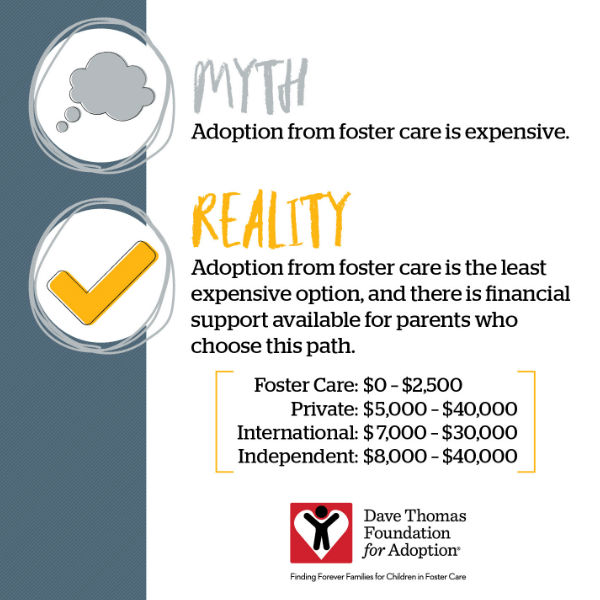The cost of fostering
By Melissa Green | Citizens Staff

The decision to become a foster parent isn’t an easy one. For some, it’s a way to help those in need on any given day, there are nearly 437,000 children in foster care in the United States. Then there are those who have always wanted to foster, and hopefully, adopt a child. “It wasn’t a matter of if we would foster, only a matter of when,” says Joanne Sharp, former foster parent and current adoptive mom of Jordyn. Fostering kids is a weighted choice with various aspects to consider; like emotional support, safety, and the overall cost.
It’s no secret that raising children can be pretty expensive, so it’s normal to wonder about the potential cost of caring for a foster child. Keep reading to learn the most common out of pocket costs of becoming a foster parent, caring for children, and — if you’re ready — adopting a foster child.

Cost to become a foster parent
Fostering is a considerable undertaking, and children in your care may have different social and emotional needs than what you’re used to. In order to provide the best care, all foster parents in the United States are required to be licensed.
The licensing process varies by state and in some states the process is different county-by-county. You’ll be required to take 10-40 hours of pre-service training which can include:
- Child development
- Behavior management and appropriate methods of discipline
- Cultural sensitivity
- Attachment, separation, and loss issues
- Home and child safety
- The impact of fostering on the foster parents’ own families
- CPR and first-aid
These state sponsored courses are often inexpensive or free, and some states will reimburse you for the training cost. Additionally, part of the licensing process is having your home inspected for safety. You may need to buy safety equipment like fire extinguishers or carbon monoxide detectors in order to pass inspection and have a child join your family.
Cost to bring a foster child home
As a foster parent, it’s your responsibility for making sure your home meets the needs of the child or children you’ll be welcoming into your family. “Most children come to your home from a very unfortunate or sudden incident,” says Joanne. “Domestic violence, homelessness, and drug abuse are common reasons. So the child is likely to have only the clothes on their back.”
If you’ll be fostering babies or toddlers, you should have everything ready to go when the child arrives —bed or crib, high chair, diapers, stroller, and a car seat . If there’s something you need, don’t be afraid to ask your social worker. “There’s a lot of support available for foster parents,” says Joanne. “[In some states] you can get baby formula, clothing, baby gear, and even furniture from the state if you ask. Daycare is also paid for if you’re working.”
Day-to-day expenses
Once you’re a licensed foster parent, there are very little, if any, out-of-pocket costs associated with caring for your foster child. Parents receive a monthly stipend and reimbursement for things like room and board, clothing, toiletries, allowance, and extracurricular activities. The child’s medical and dental expenses are covered by the state’s Medicaid program. “Jordy came to us as a one-pound preemie, born 15 weeks early,” remembers Joanne. “She had breathing machines and medication, so her stipend was higher than normal.”
Your foster child may even receive additional money for back-to-school supplies, a birthday allowance, and holiday gifts. “There's a lot of support offered. It's really a matter of taking advantage of it. The state offers additional training, counseling, and fun opportunities for the kids,” says Joanne. Your social worker should be able to give you a projected list of expenses and reimbursements, as well as any stipends you may receive.
Cost of adoption through foster care
Becoming a foster parent is an amazing help to a lot of children in need, but it’s temporary. If you’re interested in adding a permanent member to your family, adopting through the foster care system is the most inexpensive option by far.

Source: Dave Thomas Foundation for Adoption
Foster care adoption is often funded by the state, and in most cases there are few or no fees. Many states are moving towards dual licensing, so if you’re already fostering you won’t need an additional certification to adopt.
“We adopted William privately and we had to pay for everything. Roughly it cost about $30,000,” says Joanne. “Adopting Jordan through foster care was free. The state took care of all the expenses, and we’ll continue to receive a stipend for her until she’s 18.” Depending on your state, you may be eligible for post adoption assistance, such as tuition waivers or scholarships for your child once they’re ready for college. You can learn more about what to expect from the process of foster care adoption from the Dave Thomas Foundation for Adoption’s Step-by-Step Guide to Adoption.
Emotional cost of fostering children
In addition to the cost, fostering has an important emotional component as well. “It's not easy. It can be incredibly emotional and at times it truly feels like a rollercoaster, but it is the most rewarding thing you could do,” says Joanne. “You are literally giving a child a chance — maybe their only chance.”
Fostering can be a complex journey for both the parents and the kids, but there are supports in place to help you navigate the system successfully. “Loving them like they're staying, when you know they may go is the hardest thing I have ever done,” remembers Joanne. “However, seeing our kids thrive day after day, knowing that even if they go, we were able to give them a leg up in life — what could be better than that?”
Ready to become a foster parent?
If you’re ready to take the next steps as a foster parent, start by contacting your state agency. Additionally, the Dave Thomas Foundation for Adoption is a great resource for learning more about finding forever families for children in foster care. Their free resource library has adoption guides, videos, and more to help you navigate the process.

Related topics
How much does it cost to adopt a child?
5 tips for raising financially confident teens
5 financial tips for your growing family
© Citizens Financial Group, Inc. All rights reserved. Citizens Bank, N.A. Member FDIC
Disclaimer: The information contained herein is for informational purposes only as a service to the public and is not legal advice or a substitute for legal counsel. You should do your own research and/or contact your own legal or tax advisor for assistance with questions you may have on the information contained herein.
